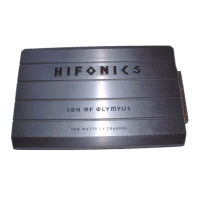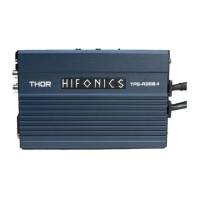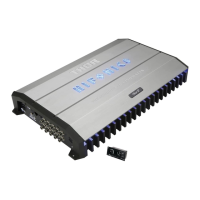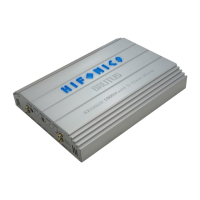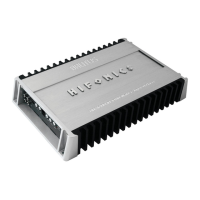14 15
E. Troubleshooting a System
E. Troubleshooting a System
E. TROUBLESHOOTING A SYSTEM
The key to nding the problem in a misbehaving sound system is to isolate parts of that system in a logical
fashion to track down the fault.
Description of the Diagnostic system built into all HIFONICS ampliers
The diagnostic system will shut down the amplier, until reset by turning the head unit off, and back on. This
condition will be indicated by the front panel PROTECT LED lighting up under the following circumstances:
1. A short circuit on the loudspeaker leads.
2. An internal amplier fault that causes a DC offset on the loudspeaker output. Should the amplier go
into diagnostic mode, simply disconnect all RCA and speaker leads, while keeping +12 volt, power
ground and remote leads connected.
Should the amplier go into diagnostic mode, simply disconnect all RCA and speaker leads, while
keeping +12 volt, power ground and remote leads connected.
1. After diconnecting the RCA’s and speakers turn the amplier back on, and if the diagnostic LED lights,
the amplier has an internal fault.
2. If the diagnostic lights are showing good condition, plug the RCA cables back, and reset the amplier. If
it goes into diagnostic now, the fault lies in the input, either with bad cables or source unit.
3. If the amplier seems ok with RCA cables plugged in, connect the speakers, one at a time, and if one
speaker or its wiring is faulty, it will activate the diagnostic system.
4. If the amplier is still in Protection mode after the above steps, remove all RCA’s and wires from the
amplier. Take a 12” length of speaker wire, trim the plastic off of each end exposing the wire. Now
connect one end of the wire to the 12V+ on the amplier and connect the other to the Ground on the
amplier. You will have a brief spark indicating that the Capacitors have been discharged and the
drivercard has been reset. Remove the jumper wire and reconnect your Power, Ground and Remote
wires. Attempt to power the amplier up like normal. In some cases this can Reset the amplier if
permanent damage has not previously been done.
Amplier heatsink overheating
The ampliers will shut down when the heatsink temperature reaches 176 degrees fahrenheit (80 degrees
centigrade), and turn back on once the unit has cooled down below that point.
Causes of overheating:
1. Inadequate cooling - relocate or remount to provide better natural airow over the ns.
2. Driving high power levels into low impedances - back off on the volume control, and conrm you are not
loading the amplier with less than the recommended loudspeaker impedance.
3. Excessive voltage drop can also cause overheating. Conrm the vehicle’s electrical system is
operating properly.
Low output power
1. Check that level controls have been set up properly.
2. Make sure that the battery voltage, as measured at the amplier’s +12 volt and ground terminals,
is 12.6 volts or more.
3. Check all +12 volt and ground connections.
Fuses blowing
1. The use of loudspeaker impedances below the recommended minimums will draw more current. Conrm
impedence for all speakers and subwoofer systems are not below reccomended levels.
2. A short on the main +12 volt cable from the battery to the vehicle chassis will cause the main fuse
to blow.
3. If an amplier fuse blows continually, with only +12 volt, ground and remote leads connected, the
amplier may be faulty.
System does not turn on
1. Check all fuses.
2. Check all connections.
3. Measure the +12 volt and remote turn on voltages at the amplier terminals. If these are non-existent or
low, take voltage measurements at fuse holders, distribution blocks, the head unit’s +12 volt and remote
leads to localize the problem.
4. If the HIFONICS lettering is illuminated but you do not have Power or Protection illuminated, simply
remove your remote wire and use a jumper wire from 12V+ on the amplier to the Remote connection
on the amplier. If the amplier turns on like normal then you do not have adequate voltage/amperage
on the Remote turn-on wire from the source unit to turn on the amplier. You will need to seek out a
certied installer to install a relay for your amplier. If the jumper does not power your amplier on,
you may have internal damage and should contact Hifonics Customer Service to locate an Authorized
Repair Center.
Noise problems
System noise can be divided into two categories, hiss, and electrical interference.
Hiss, or white noise:
1. High levels of white noise usually occurs when amplier level controls are turned up TOO HIGH. You
must re-adjust according to the procedures in section “D. Setting Up Systems to Maxximize Performance”
2. Another major problem that can cause excessive hiss, is a noisy head unit - unplug the amplier input
RCA cables, and if the hiss level reduces, the source unit is at fault.
Electrical interference:
The inside of an automobile is a very hostile electrical environment. The multitude of electrical systems, such
as the ignition system, alternator, fuel pumps and air conditioners create radiated electrical elds, as well as
noise on the +12 volt supply and ground. Remember to isolate the problem. First unplug the amplier input
RCA cables, if the noise is still present, next check the speaker leads. If the noise is gone, plug the RCA’s
back into the amplier, and investigate the source driving the amplier, one component at a time.
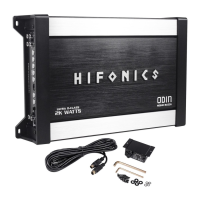
